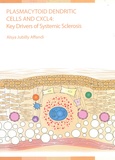Plasmacytoid dendritic cells and CXCL4
Key Drivers of Systemic Sclerosis

Affandi, Alsya
- Promoter:
- Prof.dr. T.R.D.J. (Timothy) Radstake
- Co-promoter:
- Dr. W. (Wioleta) Marut & dr. J.A.G. (Joël) van Roon
- Research group:
- Radstake
- Date:
- April 26, 2018
- Time:
- 14:30 h
Summary
Background
Systemic sclerosis (SSc), or scleroderma, is a complex autoimmune disease manifested by fibrosis in the skin and internal organs. It is characterized by a persistent inflammation, vasculopathy, and fibrosis, forming an overlapping tripartite network that drive disease pathogenesis. Owing to its complex nature and heterogeneity, SSc remains one of the greatest challenges to both investigators and physicians, and current treatment remains for many complications ineffective.
Fibrosis is attributed to the formation of myofibroblast that produces an excessive amount extracellular matrix (ECM), such as collagen. Preceding fibrotic events, immune cell infiltrate tissue and release immune mediators that facilitate fibroblast activation and ECM synthesis such as TGFβ, IL-6, and T helper type 2 cytokines. In multiple autoimmune diseases, the increase of type I interferon cytokines (IFN-I) have also been implicated. In this thesis, I focused on plasmacytoid DCs, the major producer IFN-I.
Aim of this thesis
In this thesis, my research aim was to investigate the dysregulation of pDCs in systemic sclerosis patients and to evaluate their involvement on different aspects of SSc pathogenesis, the innate-adaptive immune responses and myofibroblast transformation, through pDCs’ release of key mediator CXCL4.
Summary of findings
Part I: pDC dysregulation in systemic sclerosis patients
In Chapter 2, we performed a proteomic profiling of ex vivo culture of pDC from SSc patients7. In this study, CXCL4 has been identified to be secreted in a large amount by pDC from SSc patients. CXCL4 is a multifunctional chemokine that can target virtually all cells in the vasculature that is involved in the modulation of immune responses and angiogenesis. CXCL4 level is able to predict disease progression in the skin and lung of SSc patients. CXCL4 also enhances IFN-I production by SSc pDCs and induced skin inflammation and thickening in mouse. These indicate CXCL4 potential as a unique mechanical biomarker in SSc.
To understand potential underlying factors of pDC dysregulation in SSc, we screen transcription factors potentially regulating pDC differentiation and function in Chapter 3. We have found that transcription factor Runx3 to be downregulated in pDCs of SSc patients as compared to healthy individuals. Previously, lower Runx3 expression has been shown to enhance cDC responses to TLR activation. Similar to cDC, we demonstrate that mouse pDCs lacking Runx3 to overexpress maturation markers especially CD86 upon TLR engagement. Consequently, mice with Runx3 deficiency in DCs show higher susceptibility to bleomycin-induced fibrosis.
Another way by which pDC function in SSc patients could be regulated is epigenetic-control of gene expression by short non-coding RNAs called microRNAs (miRNAs). In Chapter 4, we have investigated the expression levels of 470 miRNAs in pDCs and we have identified miR-618 to be upregulated in SSc pDCs, that is a key miRNA regulating pDC function. The increase of miR-618 in SSc pDCs caused downregulation of its target gene IRF8, a transcription factor that is essential for pDC differentiation and function, and potentiates pDC to produce a higher IFN-α amount upon TLR9 stimulation.
Part II: CXCL4 drives systemic sclerosis pathogenesis
In the second part of the thesis, I focus on the consequence of CXCL4 increase on different aspects of SSc pathogenesis. Within the innate immune system, CXCL4 has been shown to alter transcriptomes of monocytes/macrophages, dendritic cells, and robustly modulated their function. In Chapter 5, we have found that CXCL4 is able to prime human monocytes-derived dendritic cells (moDCs) leading to their amplified response to TLR activation. Furthermore, CXCL4-moDCs show an enhanced capacity to activate CD4 and CD8 T cells, as indicated by an increased cytokine production and proliferation.
Furthermore, in Chapter 6, we have discovered CXCL4’s ability to directly skew CD4 T cells activation, specifically towards Th17 phenotype in healthy individuals, psoriatic arthritis (PsA) patients, and SSc patients (unpublished). In the joints of PsA patients, we find strong correlations of CXCL4 concentrations specifically with increased IL-17 and IL-22 levels. These implicate the pro-inflammatory effects of CXCL4 through priming of innate and adaptive immune systems.
Finally, in Chapter 7 we have demonstrated CXCL4 to be a key molecule driving fibrosis development. CXCL4 promotes differentiation of precursor cells including fibroblasts, endothelial cells and epithelial cells to produce collagens and to express myofibroblast markers such as αSMA and SM22α. Remarkably, mice with CXCL4 deficiency are protected from skin and lung fibrosis upon bleomycin treatment, and cardiac fibrosis when subjected to pressure overload.
Concluding remarks
Together these strongly support the notion of CXCL4 to play a central role in mediating inflammation and fibrosis across organs. CXCL4 can be potentially used in clinical setting as a predictor of disease progression in SSc patients. The direct involvement of pDC and pDC-derived CXCL4 on priming immune responses, suppressing vascular repair, and inducing myofibroblast transformation, make them promising candidates for therapeutic intervention in SSc and other related autoimmune-rheumatic disorders such as PsA.